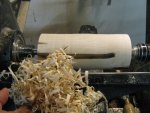- Messages
- 8,140
- Location
- The Gorge Area, Oregon
There are a bunch of ways to make turned scoops. Some seem to work better than others, and some are more aesthetically pleasing to some folks than others.
Figured I'd go ahead and document a few ways to make them as I go along and have a chance to do them, certainly haven't tried them all yet
Here's method one, it requires a couple of turning tools and a chuck.
Make it round with a tennon on the end.

Chuck it up and bore out the bulk of the material.

Its a lot easier if you can bore it close to size, otherwise you'll need to open it up some. I tried a square ended scraper but that wasn't happy, a round nose got in a bit deeper but in the end a little crook necked carbide doodad dd the job best (this is the only carbide tool I currently have, well worth it for stuff like this).

In the end you'll want something like this either way..

Turn the handle, this one is probably to thick, but works ok, just doesn't look as nice as it might.

I like to sand the bulk of the thing here since its the last chance you'll have to have the whole thing nice and round.
Mark and cut the side off, I just used a coping saw which seems to work pretty well and makes it easy to put a little curve on it.

All cut out.

Cut off the chucked up end and clean up the edges with some rasps and files and a little sanding on the details and there you go!

Figured I'd go ahead and document a few ways to make them as I go along and have a chance to do them, certainly haven't tried them all yet
Here's method one, it requires a couple of turning tools and a chuck.
Make it round with a tennon on the end.

Chuck it up and bore out the bulk of the material.

Its a lot easier if you can bore it close to size, otherwise you'll need to open it up some. I tried a square ended scraper but that wasn't happy, a round nose got in a bit deeper but in the end a little crook necked carbide doodad dd the job best (this is the only carbide tool I currently have, well worth it for stuff like this).

In the end you'll want something like this either way..

Turn the handle, this one is probably to thick, but works ok, just doesn't look as nice as it might.

I like to sand the bulk of the thing here since its the last chance you'll have to have the whole thing nice and round.
Mark and cut the side off, I just used a coping saw which seems to work pretty well and makes it easy to put a little curve on it.

All cut out.

Cut off the chucked up end and clean up the edges with some rasps and files and a little sanding on the details and there you go!







 Thanks for the tutorial!
Thanks for the tutorial!